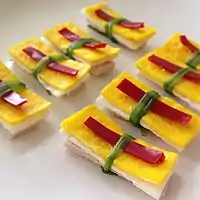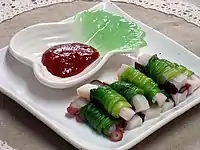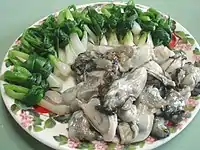Ganghoe
Ganghoe (Korean: 강회) is a variety of hoe dish of rolled and tied ribbons made with blanched vegetables such as minari (water dropworts) and silpa (thread scallions).[1] Sometimes, the vegetables are bundled into ribbons, while other times, they are tied around layered ingredients such as pyeonyuk (pressed meat slices), egg garnish, and chili threads or blanched seafood (called sukhoe).[2][3] Vegetarian versions are a part of Korean temple cuisine.[4] Ganghoe is usually dipped in chojang, the mixture made of gochujang and vinegar.[2]
 Jjokpa-ganghoe (scallion bundles) | |
| Type | Hoe |
|---|---|
| Place of origin | Korea |
| Associated national cuisine | Korean cuisine |
| Korean name | |
| Hangul | 강회 |
|---|---|
| Hanja | ﹘膾 |
| Revised Romanization | ganghoe |
| McCune–Reischauer | kanghoe |
| IPA | [kaŋ.ɦwe̞] |
Varieties
- Gosu-ganghoe (고수강회) – Raw coriander is bundled and eaten with chojang (dipping sauce made with gochujang and vinegar).[5]
- Hallyeon-ganghoe (한련강회) – Fresh Indian cress leaves, stems, and sees are bundled and served with in gochujang.[6]
- Minari-ganghoe (미나리강회) – Blanched minari (water dropworts) is tied around a 3 centimetres (1.2 in)-thick piece of pyeonyuk (pressed meat) or white part of daepa (big scallions), that is topped with chili threads and a pine nut.[7] It is commonly served as anju or banchan.
- Pa-ganghoe (파강회) – Blanched silpa (thread scallions) are tied around pyeonyuk, that is topped with a pine nut.[8]
- Silpa-ganghoe (실파강회) – Blanched silpa is bundled into ribbons and served with chojang.[9]
- Ssukgat-ganghoe (쑥갓강회) – Blanched crown daisy greens are bundled into ribbons and served with chojang.[10]
Gallery
See also
References
- "Ganghoe" 강회. Standard Korean Language Dictionary (in Korean). National Institute of Korean Language. Retrieved 20 September 2018.
- "Minari ganghoe (minari bundles with meat)". The Korea Herald. 23 March 2012. Retrieved 20 September 2018.
- Ro, Hyo-sun (29 April 2016). "[Home Cooking] Saeu ganghoe (Green onion-tied shrimp and asparagus)". The Korea Herald. Retrieved 20 September 2018.
- Kim, Ji-soo (20 January 2017). "Practice through food: Ven. Sunjae". The Korea Times. Retrieved 20 September 2018.
- "Gosu-ganghoe" 고수강회. Standard Korean Language Dictionary (in Korean). National Institute of Korean Language. Retrieved 20 September 2018.
- "Hallyeon-ganghoe" 한련강회. Standard Korean Language Dictionary (in Korean). National Institute of Korean Language. Retrieved 20 September 2018.
- "Minari-ganghoe" 미나리강회. Standard Korean Language Dictionary (in Korean). National Institute of Korean Language. Retrieved 20 September 2018.
- "Pa-ganghoe" 파강회. Standard Korean Language Dictionary (in Korean). National Institute of Korean Language. Retrieved 20 September 2018.
- "Silpa-ganghoe" 실파강회. Standard Korean Language Dictionary (in Korean). National Institute of Korean Language. Retrieved 20 September 2018.
- "Ssukgat-ganghoe" 쑥갓강회. Standard Korean Language Dictionary (in Korean). National Institute of Korean Language. Retrieved 20 September 2018.
This article is issued from Wikipedia. The text is licensed under Creative Commons - Attribution - Sharealike. Additional terms may apply for the media files.


